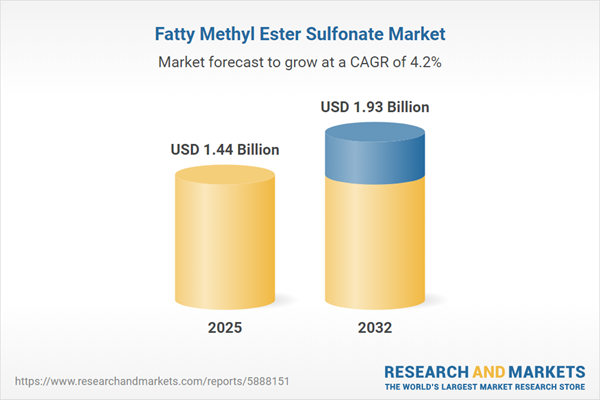Speak directly to the analyst to clarify any post sales queries you may have.
The fatty methyl ester sulfonate market is evolving rapidly as sustainable formulations become central to cleaning and personal care supply chains. Forward-thinking organizations are reconfiguring product lines and supplier networks to align with stricter environmental standards and advanced performance requirements.
Market Snapshot: Fatty Methyl Ester Sulfonate Market Growth
The global fatty methyl ester sulfonate market grew from USD 1.39 billion in 2024 to USD 1.44 billion in 2025, with sustained expansion projected at a steady CAGR of 4.18% through 2032, reaching a value of USD 1.93 billion.
Rising demand across cleaning, industrial, and personal care sectors reflects heightened priorities for biodegradability, low toxicity, and compliance with evolving sustainability mandates. Producers are reorienting their focus from cost to value, capitalizing on shifting procurement and formulator expectations.Scope & Segmentation: Categories Shaping the Surfactant Landscape
- Applications: Dishwashing detergent (automatic and manual segments); industrial cleaning (including floor and heavy-duty cleaners); laundry detergent (liquid and powder formats); personal care (bar soaps, body washes, shampoos).
- Types: Liquid (favored for solubility and formulation), powder (preferred for concentrated, lower-volume logistics).
- End Users: Household; industrial (automotive, manufacturing, oil and gas); institutional (food service, healthcare, hospitality).
- Distribution Channels: Offline (specialty stores, supermarkets, wholesalers); online (direct manufacturer sales, e-commerce platforms).
- Geographies: Americas (North and Latin America), Europe, Middle East & Africa, Asia-Pacific (including major economies and emerging growth hubs).
- Key Players: Stepan Company, Kao Corporation, Lion Corporation, SEPPIC SAS, Mitsubishi Gas Chemical Company, Clariant International, BASF SE, Solvay SA, Huntsman Corporation, UPL Limited.
Key Takeaways for Senior Decision-Makers
- Growing regulatory demands require traceable, renewable raw materials and certifications to validate environmental claims.
- Manufacturers are refining processes and expanding feedstock sources to boost consistency, reduce byproducts, and support circular economy initiatives.
- Innovations in digital technologies, such as blockchain and supply chain analytics, enhance real-time quality assurance and procurement strategy.
- Market dynamics have shifted toward value-driven partnerships where performance differentiation—like foaming stability and skin compatibility—is increasingly critical.
- Consolidations and acquisitions are broadening product portfolios, facilitating access to advanced chemistries, and unlocking new sectoral applications (including agriculture and textiles).
- Regional policy variations, such as stricter biodegradability requirements in Europe and renewable chemical incentives in the Americas, guide investment in local supply chains and manufacturing corridors.
Tariff Impact on Trade and Supply Chain Resilience
Recent US tariff regime changes have triggered an immediate recalibration of sourcing and distribution strategies throughout the fatty methyl ester sulfonate value chain. Stakeholders have adopted domestic feedstock solutions and multi-year international sourcing agreements to manage cost fluctuations. Logistics teams are optimizing shipping corridors and inventory through consolidated forecasting, reinforcing supply chain resilience across both domestic and export markets.
Methodology & Data Sources
This market analysis synthesizes insights from primary interviews with producers and procurement specialists alongside secondary research from regulatory filings, technical journals, and sustainability disclosures. Analytical rigor is ensured by cross-validating trends and cost models, allowing for comprehensive evaluation of both quantitative metrics and strategic market drivers.
Why This Report Matters: Strategic Advantages for Stakeholders
- Offers actionable insights for aligning product portfolios with regulatory and consumer sustainability preferences in key regions.
- Supports leadership decisions on capital allocation, risk mitigation, and strategic collaborations with supply chain partners.
Senior executives will find targeted recommendations for leveraging digital tools, innovating with renewable feedstocks, and expanding through regional partnerships.
Conclusion
The evolving fatty methyl ester sulfonate sector stands at the intersection of performance, sustainability, and supply chain innovation. Organizations equipped with data-driven strategies and collaborative networks will realize distinctive long-term value as the market landscape transforms.
Additional Product Information:
- Purchase of this report includes 1 year online access with quarterly updates.
- This report can be updated on request. Please contact our Customer Experience team using the Ask a Question widget on our website.
Table of Contents
3. Executive Summary
4. Market Overview
7. Cumulative Impact of Artificial Intelligence 2025
Companies Mentioned
The companies profiled in this Fatty Methyl Ester Sulfonate market report include:- Stepan Company
- Kao Corporation
- Lion Corporation
- SEPPIC SAS
- Mitsubishi Gas Chemical Company, Inc.
- Clariant International Ltd
- BASF SE
- Solvay SA
- Huntsman Corporation
- UPL Limited
Table Information
| Report Attribute | Details |
|---|---|
| No. of Pages | 182 |
| Published | October 2025 |
| Forecast Period | 2025 - 2032 |
| Estimated Market Value ( USD | $ 1.44 Billion |
| Forecasted Market Value ( USD | $ 1.93 Billion |
| Compound Annual Growth Rate | 4.1% |
| Regions Covered | Global |
| No. of Companies Mentioned | 11 |









